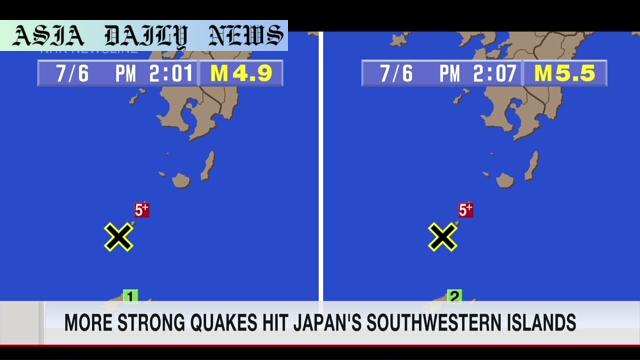Seismic Activity soars in Kagoshima as 2 strong quakes of magnitudes 4.9 and 5.5 strike Akusekijima; over 1,500 quakes recorded since June.

Seismic Turmoil Engulfs Kagoshima Prefecture
The Kagoshima prefecture in southwestern Japan has been at the epicenter of heightened seismic activity, with over 1,518 earthquakes recorded since June 2023. This concentration of geological disturbances has primarily impacted the Tokara island chain, including the remote island of Akusekijima. On Sunday, the Japan Meteorological Agency reported two significant quakes striking the island in quick succession. The first tremor, registering a magnitude of 4.9, was recorded at 2:01 p.m., followed by a more substantial quake of magnitude 5.5 at 2:07 p.m., both achieving an intensity level of upper 5 on the Japanese seismic scale.
Sunday’s Earthquakes and Their Implications
These recent quakes follow a pattern of increased seismic volatility in the region. Akusekijima, a largely uninhabited island, endured a lower 6 intensity tremor on Thursday and an upper 5 intensity earthquake on Saturday. Such geological unpredictability underscores a concerning trend for the Tokara island chain, an area nestled within an active seismic zone. The Japan Meteorological Agency attributes these events to heightened geotectonic movements, cautioning residents and local authorities to remain vigilant for potential quakes of up to lower 6 intensities in the near term.
Contextualizing the Data
For perspective, this year’s seismic activity in the Tokara islands surpasses that of both 2021 and 2023 during similar periods of heightened activity. The profound frequency—over 1,500 tremors of magnitude 1 or more within three months—is staggering yet indicative of Japan’s dynamic geological realities. Notably, Japan sits on the Pacific Ring of Fire, a tectonic hotbed responsible for roughly 90% of the world’s earthquakes. Urban planning and building design heavily consider disaster resilience, given the country’s complex history with catastrophic seismic events.
Preparedness and Precautionary Measures
The Japan Meteorological Agency continues to emphasize the importance of proactive measures for the local population. Emergency services and disaster mitigation protocols are at heightened readiness, aiming to reduce risks associated with larger-scale temblors. Evacuation plans and early warning systems are critical components of Japan’s earthquake readiness infrastructure, especially in vulnerable areas such as Kagoshima and the surrounding islands. Historical data and real-time monitoring enable officials to predict potential hotspots, but the unpredictability of seismic behavior demands constant vigilance.
Broader Implications for the Region
Beyond the immediate physical risks to life and property, this upsurge in seismic activity impacts the region’s socio-economic stability. While the Tokara islands are sparsely populated, their geological disturbances reverberate across nearby urban centers and disrupt maritime and air traffic. Moreover, such phenomena affect tourism and maritime industries pivotal to the regional economy. This scenario reinforces the importance of global collaboration in seismic research and the advancement of predictive technologies to mitigate future risks.
As Kagoshima and its neighboring regions navigate these tremors, the resilience of the local population and the efficacy of disaster preparedness strategies are tested. With over 1,518 quakes recorded this year alone, the seismic story unfolding in southwestern Japan is one of vigilance, adaptation, and reliance on scientific advancements to safeguard communities.
Commentary
Understanding the Crisis in Southwestern Japan
The recent surge in seismic activity across Japan’s Kagoshima prefecture paints a vivid picture of a nation constantly grappling with the forces of nature. Nestled in a tectonically active region, the country is no stranger to earthquakes, and yet, every bout of heightened activity reminds us of the enormity of the challenge. Akusekijima, a remote island within the Tokara chain, has become the focal point of this upheaval, enduring not one or two but over 1,500 tremors since June. The statistics alone are sobering, but the broader implications bring them into even sharper focus.
Living in the Shadow of the Ring of Fire
As a part of the Pacific Ring of Fire, Japan experiences nearly constant seismic activity. This reality shapes the daily lives of its residents, particularly in regions like Kagoshima. From reinforced infrastructure to meticulously rehearsed disaster drills, Japan has long been a leader in earthquake preparedness. However, the unpredictability of seismic events always leaves room for concern. Sunday’s quakes, registering magnitudes of 4.9 and 5.5, may not have caused widespread destruction due to the sparse population on Akusekijima, but their power serves as a stark warning for the vulnerabilities of more densely populated areas.
A Testament to Resilience and Scientific Advancement
The response to these events showcases the resilience of Japan’s communities and the effectiveness of its scientific endeavors. The Japan Meteorological Agency’s early warnings and accurate assessments provide critical information, allowing residents and officials to act swiftly in times of crisis. Still, the sheer frequency of these quakes this year underscores the need for ongoing investment in seismic research and technology. Such advancements not only serve Japan but also contribute to global understanding and preparedness for natural disasters.
Looking Ahead
As we monitor the situation in Kagoshima, there is an undeniable hope that these tremors will subside. Yet, the current crisis reinforces the necessity of vigilance and adaptation. For the families and communities affected, it is a time of unease, tempered by the knowledge that they are not alone. Japan’s robust infrastructure, coupled with its adaptive spirit, offers reassurance in these uncertain times. As we look to the future, it is essential to continue fostering international collaboration in disaster research and readiness, ensuring a safer world for all.


